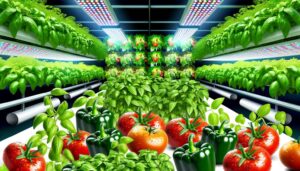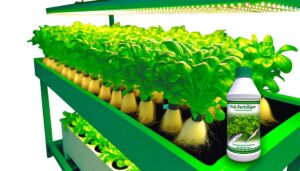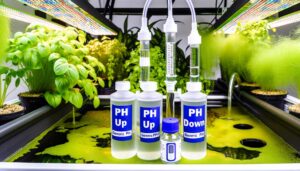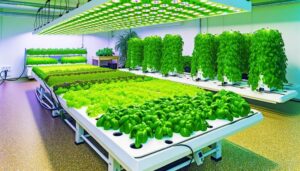How to Use Masterblend in Hydroponics
Utilizing Masterblend in hydroponics requires precise nutrient formulation to maximize plant growth and yield. Start with their 4-18-38 formula, paired with calcium nitrate and magnesium sulfate, to create a balanced solution.
Measure 2.4 grams each of Masterblend and calcium nitrate, plus 1.2 grams of magnesium sulfate per gallon of water. Dissolve each component separately before combining.
Maintain water temperature at 65-75°F and pH between 5.5-6.5 for peak nutrient uptake. Store the mixed solution in a cool, dark place, and monitor pH and EC levels regularly.
For further intricacies of hydroponic techniques, additional steps are available.
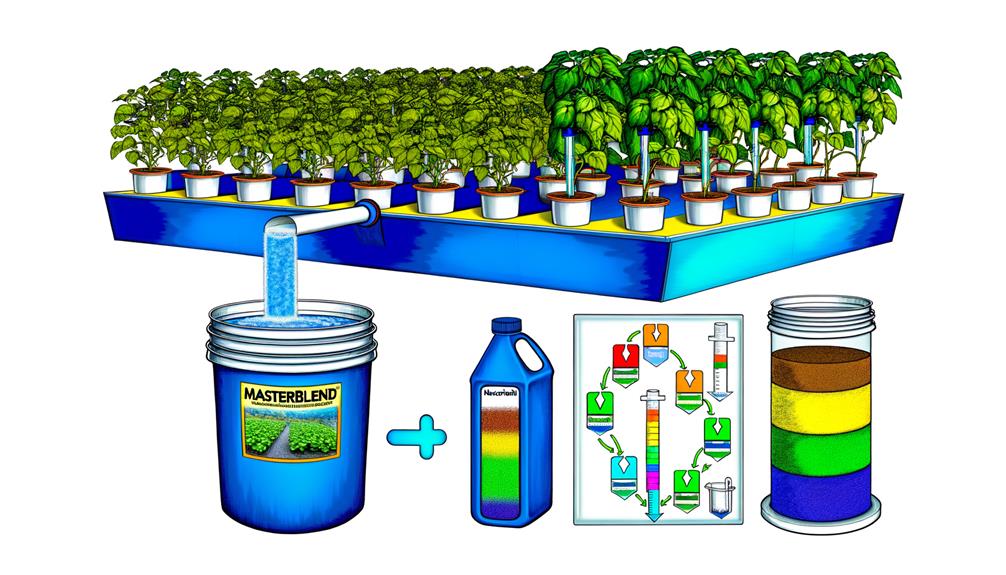
Key Takeaways
- Mix 2.4 grams Masterblend, 2.4 grams calcium nitrate, and 1.2 grams magnesium sulfate per gallon of water.
- Maintain water temperature between 65°F and 75°F for optimal nutrient solubility.
- Adjust pH to 5.5-6.5 using pH up or down solutions for maximum nutrient uptake.
- Regularly monitor pH and EC levels to prevent nutrient lockout.
Choosing Masterblend Products
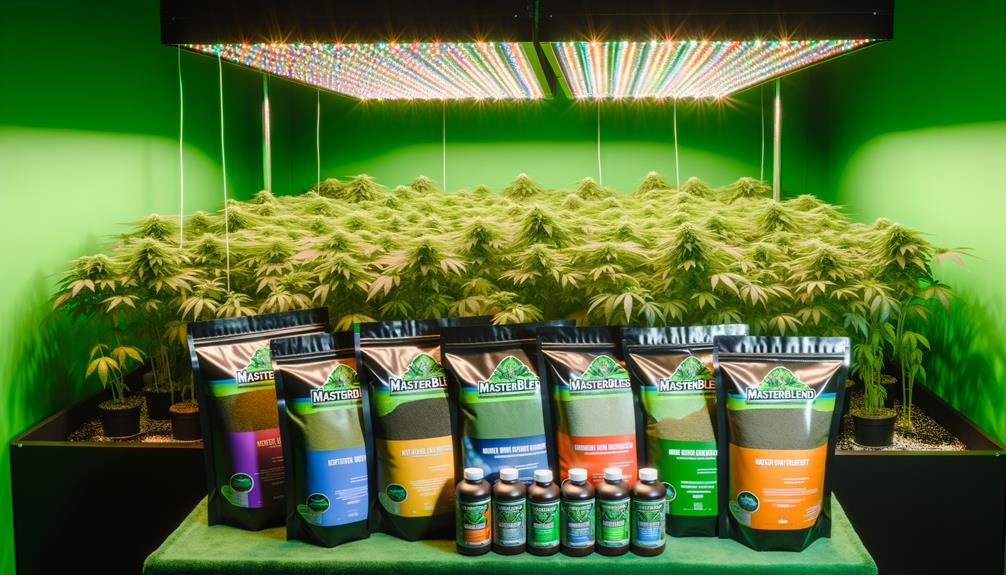
Selecting the appropriate Masterblend products is crucial for enhancing nutrient delivery and achieving maximum growth efficiency in hydroponic systems.
Masterblend's 4-18-38 formula is specifically designed to provide a balanced nutrient profile, essential for various plant growth stages. This product contains precise ratios of nitrogen, phosphorus, potassium, and essential micronutrients, facilitating robust root development and vigorous vegetative and flowering phases.
For best results, it is imperative to pair Masterblend with calcium nitrate and magnesium sulfate, which complement its nutrient spectrum, providing thorough nourishment.
Understanding the specific nutrient requirements of your crops allows for tailored adjustments, maximizing yield and quality.
Accurate measurement and careful mixing are critical to prevent nutrient lockout and guarantee homogenous distribution within the hydroponic solution.
Gathering Necessary Supplies
A thorough checklist of essential supplies is pivotal to successfully implementing Masterblend in a hydroponic system.
First, procure Masterblend 4-18-38, Calcium Nitrate (CaNO3), and Magnesium Sulfate (Epsom salts) to create the nutrient solution. Accurate digital scales are necessary for precise measurement of these compounds.
pH and EC meters are indispensable for monitoring solution parameters. Suitable reservoirs and mixing containers facilitate proper nutrient dissolution and storage.
Hydroponic systems vary, so verify compatibility of your setup with chosen grow trays, net pots, and growing media such as rockwool or clay pellets.
Understanding Nutrient Ratios
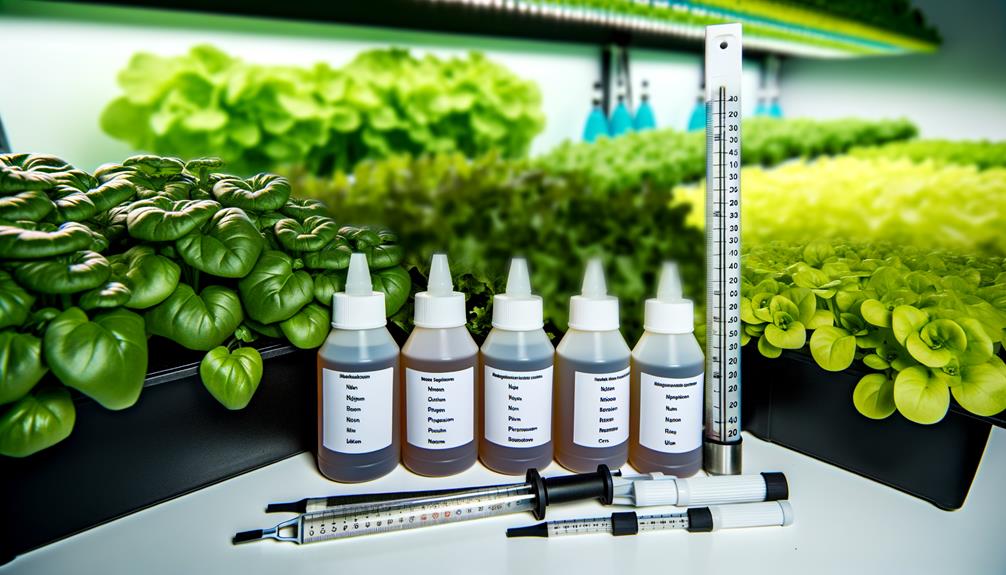
Understanding the precise nutrient ratios in your Masterblend solution is vital to achieving ideal plant growth and development in a hydroponic system. Masterblend's balanced formulation typically includes a combination of nitrogen (N), phosphorus (P), and potassium (K), often referred to as N-P-K. Each element serves a specific role: nitrogen fosters vegetative growth, phosphorus enhances root development, and potassium improves overall plant health and disease resistance. To guarantee proper nutrient uptake, it is vital to adhere to the recommended ratios.
| Nutrient | Role in Plant Growth | Recommended Ratio |
|---|---|---|
| Nitrogen (N) | Vegetative growth | 4 |
| Phosphorus (P) | Root development | 18 |
| Potassium (K) | Overall health and resistance | 38 |
| Calcium (Ca) | Cell wall structure | 7 |
| Magnesium (Mg) | Photosynthesis and enzyme function | 4 |
Such precision in nutrient management aids in optimizing growth cycles and yields.
Mixing the Nutrient Solution
To achieve ideal nutrient uptake in hydroponic systems, it is imperative to adhere to precise ingredient measurements when preparing the Masterblend solution.
Following a step-by-step mixing protocol guarantees uniform distribution of nutrients, while maintaining the water temperature between 65-75°F enhances solubility and nutrient availability.
This meticulous approach assures consistent plant health and growth performance.
Exact Ingredient Measurements
Precise measurement of ingredients is essential for creating an ideal nutrient solution using Masterblend in hydroponics.
Accurate weighing of Masterblend, calcium nitrate, and magnesium sulfate is critical to maintain maximum nutrient balance. Typically, a standard mix ratio involves 2.4 grams of Masterblend, 2.4 grams of calcium nitrate, and 1.2 grams of magnesium sulfate per gallon of water.
Utilizing a high-precision digital scale guarantees that these measurements are exact, preventing nutrient imbalances that could hinder plant growth. Additionally, it is advisable to measure each component individually to avoid cross-contamination.
Implementing a consistent and accurate measurement routine will facilitate the creation of a nutrient solution that supports vigorous and healthy hydroponic plant development.
Step-by-Step Mixing
Guaranteeing a homogenous nutrient solution starts with dissolving the Masterblend fertilizer in a portion of the total water volume, stirring thoroughly to achieve complete dissolution. Next, add the calcium nitrate and stir until fully dissolved. Finally, incorporate the Epsom salt, confirming each component is completely integrated before moving to the next. Precision in measurement and mixing is vital to avoid nutrient imbalances that can affect plant growth. Below is a recommended sequence for mixing:
| Step | Action |
|---|---|
| 1 | Dissolve Masterblend in partial water |
| 2 | Add calcium nitrate and stir |
| 3 | Incorporate Epsom salt and mix |
Adherence to this methodology guarantees an evenly distributed and efficacious nutrient solution for peak hydroponic performance.
Optimal Water Temperature
Maintaining an ideal water temperature between 65°F and 75°F is crucial for maximizing nutrient solubility and uptake efficiency in hydroponic systems. Within this temperature range, the solubility of Masterblend components such as nitrogen, phosphorus, and potassium is enhanced, guaranteeing that plants can readily absorb the nutrients.
Additionally, maintaining this temperature range minimizes the risk of microbial proliferation, which can otherwise compromise root health and nutrient uptake.
Employing advanced techniques such as using water chillers or heaters allows for precise control of water temperature. Continuous monitoring with calibrated digital thermometers assures consistency.
Deviations from the optimal range can result in reduced nutrient availability and stress on plant roots, ultimately affecting overall plant health and yield.
Adjusting Ph Levels
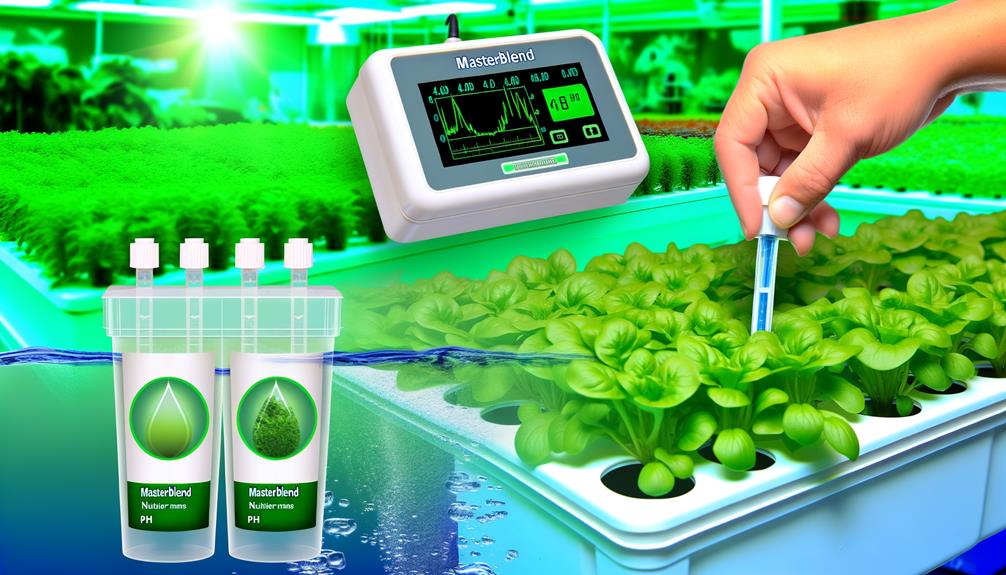
Maintaining the ideal pH range of 5.5 to 6.5 is essential for best nutrient absorption when using Masterblend in hydroponics.
Regular monitoring with precise pH meters guarantees that the solution remains within this range, preventing nutrient lockout.
When pH imbalances occur, corrective measures using pH up or pH down solutions should be promptly applied to restore equilibrium.
Ideal Ph Range
Achieving the ideal pH range between 5.5 and 6.5 is crucial for maximizing nutrient uptake and ensuring the health of hydroponically grown plants. Within this range, nutrients such as nitrogen, phosphorus, and potassium become readily available, enhancing plant growth. To adjust pH levels effectively, it is important to use precise chemical solutions and advanced techniques.
Key considerations include:
- Buffer Solutions: Utilize buffer solutions to stabilize the pH.
- Acid and Base Additives: Employ pH increasers (bases) and decreasers (acids) cautiously.
- Incremental Adjustments: Make gradual changes to prevent pH shock to plants.
Understanding these factors is crucial for maintaining an ideal hydroponic environment.
Monitoring Ph Levels
Accurately monitoring pH levels in hydroponic systems is imperative for sustaining ideal nutrient availability and plant health. Utilizing advanced pH meters, growers can achieve precise readings essential for fine-tuning nutrient solutions.
Regular calibration of pH meters guarantees accuracy, mitigating the risk of erroneous data. Digital meters with automatic temperature compensation (ATC) provide consistent and reliable measurements, accounting for temperature fluctuations.
It is advisable to conduct pH assessments daily, as nutrient uptake can cause rapid pH shifts. Maintaining a log of pH readings facilitates trend analysis, enabling proactive adjustments.
Additionally, integrating pH control systems can automate monitoring and minor corrections, enhancing stability. Understanding these techniques is critical for optimizing the performance of Masterblend formulations in hydroponic setups.
Correcting Ph Imbalances
Correcting pH imbalances in hydroponic systems necessitates the precise application of pH adjusters to guarantee prime nutrient uptake and plant health.
Utilizing pH Up and pH Down solutions allows growers to fine-tune the pH levels within the ideal range of 5.5 to 6.5. Accurate pH management guarantees that Masterblend nutrients are effectively absorbed by plants.
Key steps include:
- Measuring pH levels: Employ high-precision pH meters to monitor fluctuations.
- Applying pH adjusters: Use pH Up or pH Down solutions incrementally to achieve the desired pH.
- Mixing solutions properly: Ensure thorough mixing to prevent localized imbalances.
This meticulous approach to pH adjustment fosters robust plant growth and maximizes yield.
Storing the Solution
Properly storing the Masterblend solution is essential to maintaining its efficacy and preventing nutrient degradation. For ideal preservation, the solution should be kept in a cool, dark place to minimize exposure to light and temperature fluctuations, which can degrade nutrient quality. Verify the storage container is airtight to prevent contamination and evaporation. Regularly inspect the solution for any signs of precipitate formation, which can indicate nutrient imbalance or contamination.
| Storage Condition | Recommended Practice |
|---|---|
| Temperature | Store between 50-70°F (10-21°C) |
| Light Exposure | Keep in a dark environment |
| Container Type | Use airtight, opaque containers |
| Inspection | Check monthly for precipitates |
Feeding Your Plants
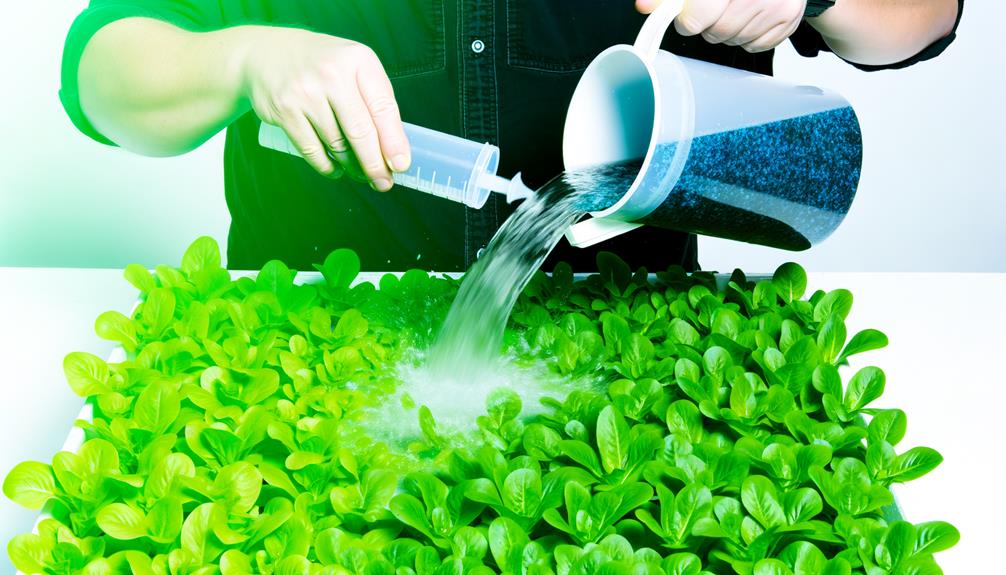
Once your Masterblend solution is properly stored, the next step involves determining the precise nutrient dosage to effectively feed your hydroponic plants. To achieve optimal plant growth, use a ppm meter for hydroponics to measure the nutrient concentration in your solution. This ensures that your plants receive the appropriate balance of minerals without the risk of over- or under-fertilization. Regular monitoring and adjustments will help maintain a stable nutrient environment for healthy and vigorous plant development.
Accurate nutrient dosing is critical to guaranteeing peak growth and maximizing yield. Begin by calculating the Electrical Conductivity (EC) of your solution, aiming for the ideal range specific to your plant species.
Key considerations include:
- Plant Growth Stage: Adjust nutrient concentrations according to whether plants are in the vegetative or flowering phase.
- Solution pH: Maintain pH levels between 5.5 and 6.5 to enhance nutrient absorption.
- Water Temperature: Keep the solution between 65°F and 75°F to improve root uptake.
Properly managing these variables will guarantee robust plant health and productivity.
Monitoring Plant Health
Effectively monitoring plant health in hydroponic systems involves regularly evaluating visual indicators, nutrient levels, and environmental conditions to preemptively address any potential issues. Key visual indicators include leaf color, root condition, and overall plant vigor. Nutrient levels should be meticulously measured using EC and pH meters to guarantee ideal absorption. Environmental conditions like temperature, humidity, and light intensity must be consistently regulated to maintain a perfect growing environment.
| Indicator | Ideal Range | Monitoring Frequency |
|---|---|---|
| Leaf Color | Vibrant Green | Weekly |
| Root Condition | White and Firm | Bi-weekly |
| EC Levels | 1.2 – 2.0 mS/cm | Daily |
| pH Levels | 5.5 – 6.5 | Daily |
| Temperature | 68-75°F (20-24°C) | Continuous |
Troubleshooting Common Issues
Identifying and resolving common issues in hydroponic systems requires a thorough understanding of the potential problems and their underlying causes.
One frequent issue is nutrient imbalance, which can manifest as deficiencies or toxicities affecting plant health. To effectively troubleshoot, consider the following:
- pH Fluctuations: Regularly monitor and adjust the pH levels to maintain the ideal range (5.5-6.5) for nutrient absorption.
- Water Quality: Make certain the water source is free from contaminants and has a stable electrical conductivity (EC) level.
- Root Health: Inspect roots for signs of rot or disease, which can impede nutrient uptake and overall plant growth.
Conclusion
In the domain of hydroponics, mastering the use of Masterblend products is akin to conducting a symphony where each element must harmonize perfectly.
By meticulously selecting products, understanding nutrient ratios, and precisely mixing and adjusting nutrient solutions, one can nurture plants to their ideal health.
Vigilant monitoring and adept troubleshooting guarantee the garden thrives.
When executed with precision, this process transforms the hydroponic system into a well-oiled machine, producing bountiful harvests with scientific exactitude.



